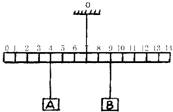问题
填空题
如图,轻杆上刻有均匀刻度线,用细线穿过“7”处的小孔后悬挂于固定点O,现将A、B两物体分别挂在“4”和“9”刻度线处时,轻杆恰能保持水平;那么把A挂在______刻度线、B挂在______刻度线也能使轻杆保持水平.

答案
根据杠杆的平衡条件:GA?3L=GB?2L
所以
=GA GB
,根据杠杆的平衡条件,要使杆平衡应满足2 3
=LA LB 3 2
所以A可以挂在1的位置,此时力臂为6,B挂在11,此时力臂为4.
故答案为:1;11.
